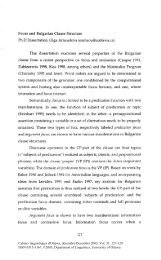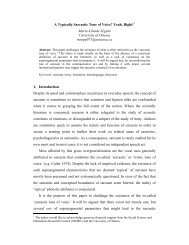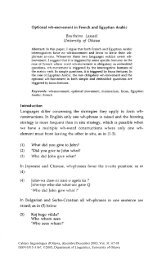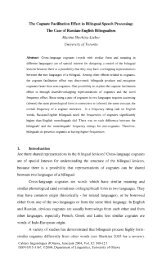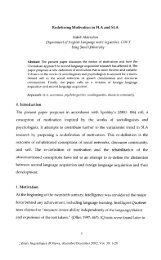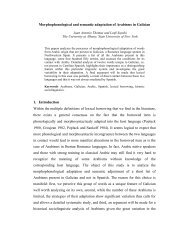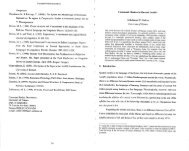Interlingual and Intralingual Interference during Gender Production
Interlingual and Intralingual Interference during Gender Production
Interlingual and Intralingual Interference during Gender Production
Create successful ePaper yourself
Turn your PDF publications into a flip-book with our unique Google optimized e-Paper software.
Denisa Bordag<br />
children, Mills (1986) observes that similarly to the second language learners,<br />
also German children have least problems with acquisition of feminine gender of<br />
nouns ending with -e <strong>and</strong> show difficulties with acquisition of gender of nouns<br />
with consonantal termination.<br />
4. Conclusion<br />
According to the results of this study there seem to be at least three factors<br />
affecting gender production in a second language:<br />
(1) The gender of the corresponding first language translation equivalent<br />
(interlingual interference/transfer).<br />
(2) The phonological form of the to-be-selected second language noun<br />
(intralingual interference/transfer),<br />
(3) <strong>Gender</strong> information saved on the second language lemma (otherwise<br />
subjects would not be able to produce the correct gender of nouns whose<br />
gender differs from that of their first language translation equivalent<br />
<strong>and</strong>/or has an atypical termination).<br />
The gender errors reported in the language of Czech <strong>and</strong> German children<br />
are also in accordance with the hypothesis that at least in the early stages of<br />
language acquisition children assign gender on the basis of phonological form of<br />
a noun. As native speakers later achieve full competence in gender production<br />
<strong>and</strong> can retrieve grammatical gender very fast without making errors, it is<br />
assumed by the models of adult language speech production that the information<br />
about grammatical gender is stored.<br />
Inlight of the findings reported in this paper it however does not seem to be<br />
necessarily the case that grammatical gender of second language nouns is stored<br />
as their inherent property in the same way as it is assumed for native languages.<br />
It is more likely that the grammatical gender of second language nouns is<br />
computed each time it is needed anew on the basis of stored information,<br />
information coming from the first language lemmas <strong>and</strong> information coming<br />
from the phonological form. In this aspect the second language gender<br />
production seems to be closer to the child than to the adult language processing.<br />
18



